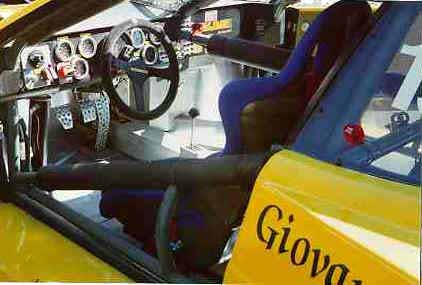|
|
|
The first step was gutting everything out of the original GT4. The interior was stripped, all the glass was removed and a full roll cage installed. The glass was replaced with Lexan as was the rear engine compartment cover.The floor panels were replaced with aluminum diamond plate and the firewall at the engine compartment was removed and replaced with removeable panels giving easier access to the back side of the engine. The removeable inner rear wheel-well panels give further access. To make engine removal/installation easier some of the structural steel members surrounding it were repositioned. The doors were redesigned using 3/8" aluminum honeycomb for the frame and reinforcing ribs. The outside panel of the door was made using aluminum sheet bonded to Kevlar(facing inside), while the interior "skin" was made using aluminum sheet bonded to a Kevlar/carbon fiber material.The final result was a door that weighed a mear 7 1/2 lbs. and was extremely strong.
The body modifications were next. Careful consideration was given to fender widths to accommodate racing wheels and tires as well as the neccessary cooling for the various systems. NACA ducts were designed into the bodywork for cooling the passenger compartment, front and rear brakes, engine oil cooler, transmission oil cooler, the oil pump, and both headers. A separate NACA duct with "scoop" was cut into roof just above rear window to "feed" the engine induction system. After the design of the body style, "bucks" were made inorder to build molds for final construction of the body panels. Then we took an air chisel and cut 90% of the steel body panels off the car and replaced them with the newly fabricated panels. These new panels were "hand laid" fiberglass/Kevlar construction. The exterior was several layers of fiberglass for ease of sanding/painting, the
interior surface was Kevlar for strength & toughness. The rocker panels
were then lightened using the same construction method as the doors. The entire front hood is removeable for access to
radiator, master cylinder, brake/clutch pedals, windshield wipers,
front suspension, battery etc. In order to improve stability at speed an adjustable rear wing (actually 2-small & 1- larger, independently
adjustable) was installed the rear. The airfoil properties were selected
based on min. drag yet yielding max. downforce in the extreme position. The bottom structural member of the front radiator air
intake (grill) is an inverted airfoil for greater downforce on the
front suspension. If the rear tailights don't look stock there's a good reason: their from a school bus.

A new dash was installed using a full compliment of AUTOMETER gages. The guages measure such critical factors as RPMs. amps, fuel pressure, engine oil pressure, transmission oil pressure, engine oil temperature, transmission oil temperature, and of course water temperature. A Haylon fire suppression system was installed behind the drivers seat. There are 2- seats made by OMP of Kevlar/carbon fiber construction each with Simpson 5-point safety harness. Tire changes are made easier with the 4- pneumatic air jacks that were installed, 2-behind the front wheels & 2-behind the rear wheels.
Dry weight now is approx. 2300 lbs.